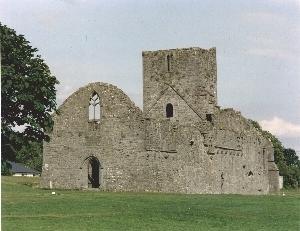

The Augustinians were invited to Callan at the request of the Butlers of Ormonde. In 1461 Edmund Butler, cousin of the Earl of Ormonde asked Pope Pius II for a foundation of the Augustinains. This request was granted that year, and the Abbot of Ferns was requested to send a community to establish a foundation in Callan. However Edmund Butler died around 1463 fefore the work had started on the building of the friary; and it fell to his son James Butler to take up the work. The building was begun in 1468, and finished about three years later.
In 1472, shortly after it was founded, the Community in Callan, requested the Prior General in Rome, to constitute their house, a house of Observants, that is a Community of strict observance. It was affiliated to the house of Sancta Maria del Populo in Rome, and directly under the prior general, not under the English Province.
The Observant communities believed that academic learning was very important, so it is no surprise that the Friary in Callan became known as a seat of learning. It had a wonderful library which contained many valuable books and manuscripts. Since the Friars were preachers of the Gospel they needed access to a library when preparing their sermons, also it was more than likely that some of the younger Augustinians spent some of their year of formation and study in Callan.
In December 1540 the Friars had to leave their monastery in Callan, because they refused to acknowledge king Henry II as head of the Church. The Friary, church and grounds were confiscated and leased to Sir James Butler for 21 years. This James Butler, grandson of the founder, was a strict Protestant and a staunch supporter of the King. The Friars were scattered, some went to their families, some to other communities, others escaped to the Continent, but the majority went to the hills, where they lived in hiding, and continued to minister to the local people.
In 1614 Walter Butler succeeded as Earl of Ormond. He was a saintly man, very generous and protective of all clergy, secular and regular. He allowed the Friars to return to the old Abbey around 1641. It seems from a study of the ruins of the old church that they went to live in the Church Tower, and had it re-modelled as living quarters. Meanwhile they started to re-roof the Church, so that it could be used for worship, and they planned to re-build the Friary which was beyond which was beyond repair.
Amhlaoibh O Suilleabhain refers to the old abbey as "a former house of dragoons" which would imply that it was used as a barracks at some time.
In March 1650 Cromwell came on his tour of death and destruction. He ransacked the town, killing, burning and looting and once again the friary was in ruins and the Friars scattered.
Brighter days dawned for Irish Catholics with the restoration of Charles II. The Augustinians were recalled from exile, and set about re-building their priories.
In 1661 Denis Fitzpatrick was appointed prior in Callan, and he had to find a home for his Community. He probably bought a two-storey thatched house in Clodeen Lane for the priory, and two small rooms nearby, which could be used as the chapel. From here the Friars ministered to the people of Callan, up to 1810, with some interruptions.
One of these interruptions occurred in 1697, during the Penal Times, when a decree banishing all Catholic Archbishops, Bishops, monks and friars from the Kingdom "on pain of imprisonment or transportation" was published. The Prior of callan went into exile, but not all the friars left. some registered as parish priests and were allowed to remain, as according to the Penal Laws one priest was allowed to remain in each parish, provided he had no assistant. The other friars remained around the area in disguise, and kept in touch with the people. Many of the priests in the Callan area found refuge in Westcourt House, the home of a Catholic branch of the Butlers of Ormonde. This family was extremely generous and helped many of the local clergy during the Penal Times.
It seems that during this time of upheaval some friars continued to reside secretly in the Friary in Callan, because in 1724, when the Augustinians held their provincial chapter Callan is mentioned as one of the houses to which a prior was appointed. Later after 1781, Callan is named as one of the six houses where there was a novitiate. In 1803 a new church was built.